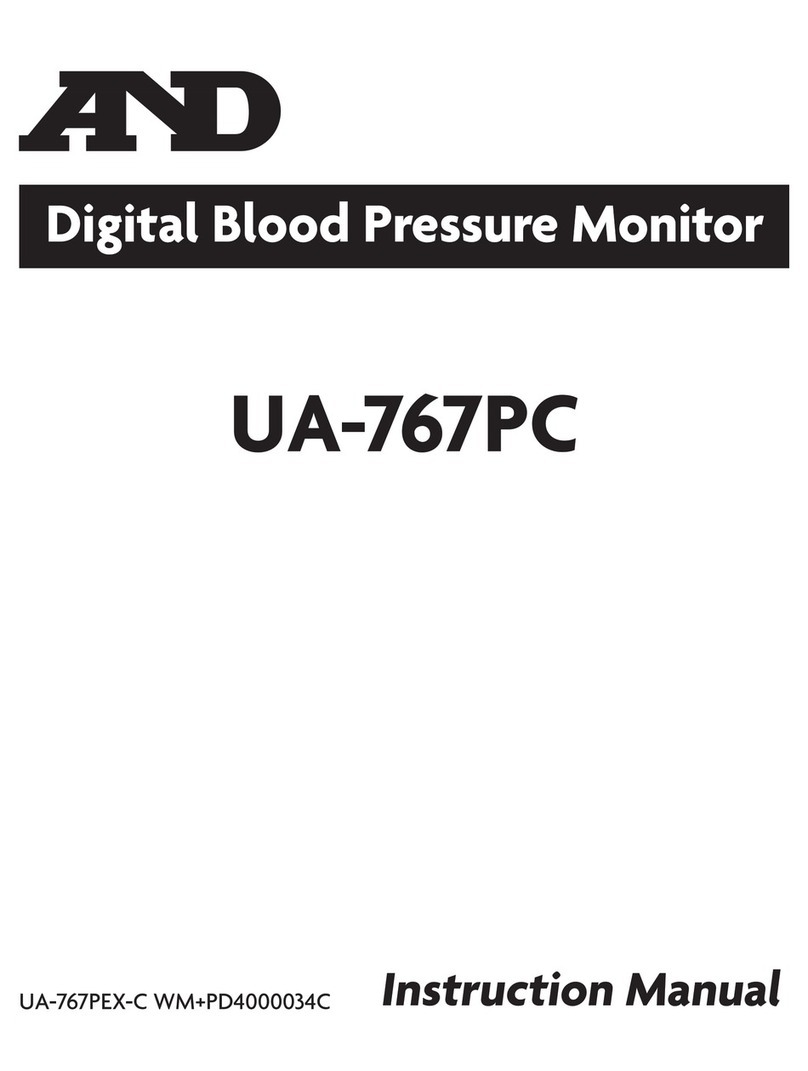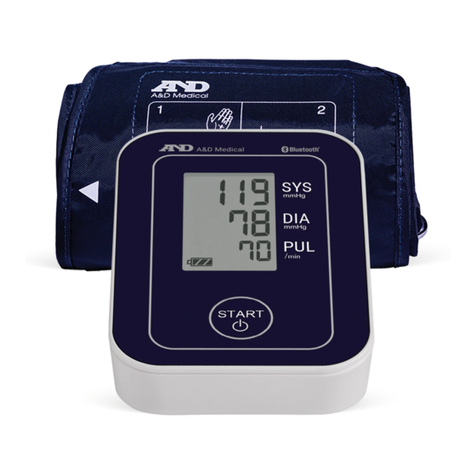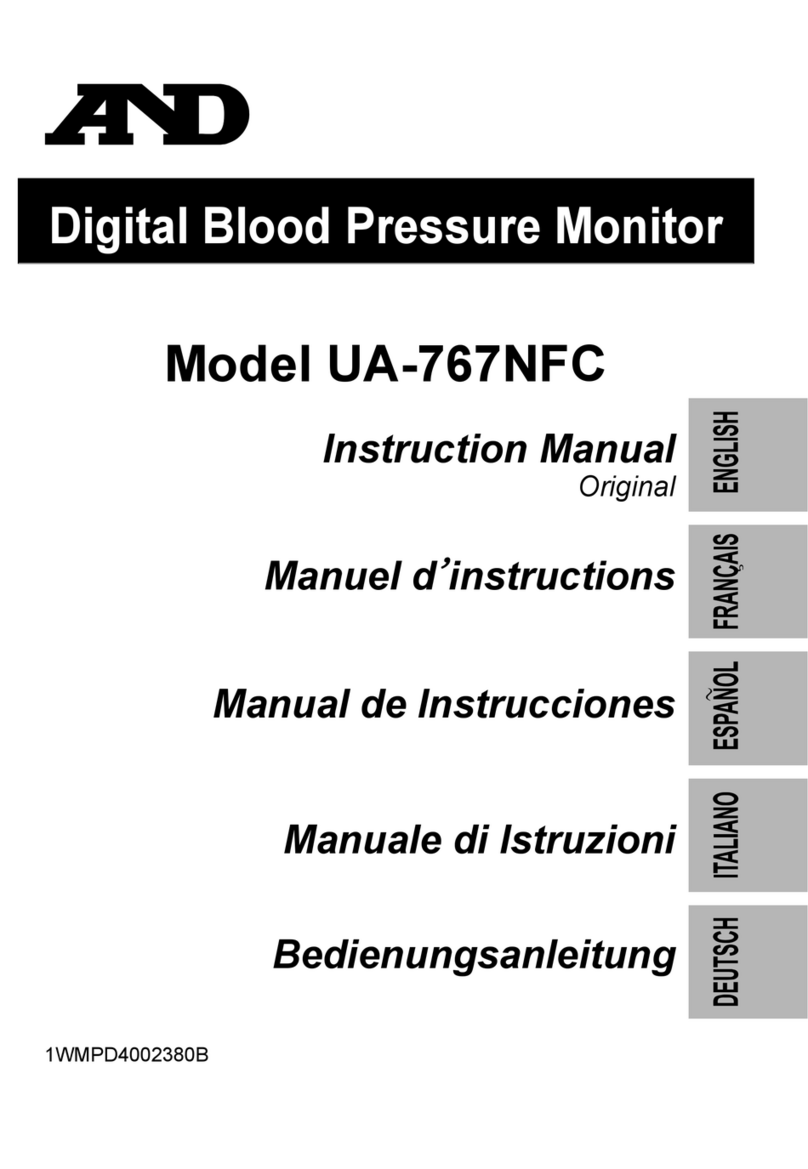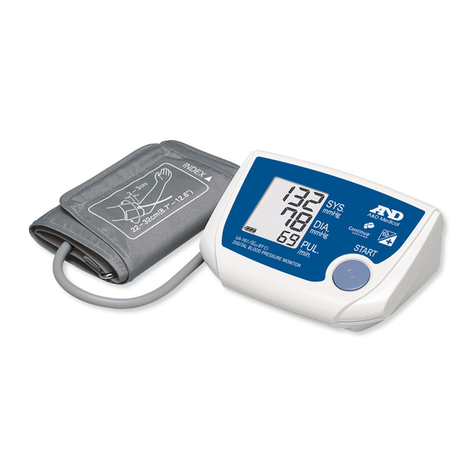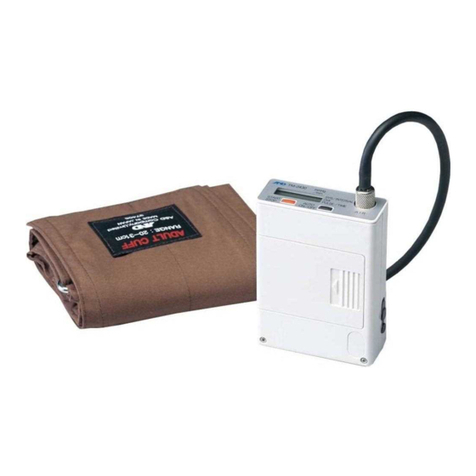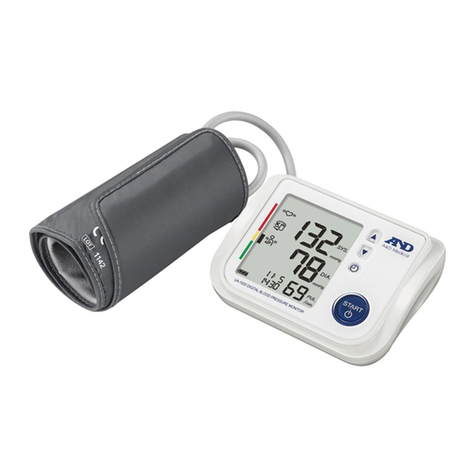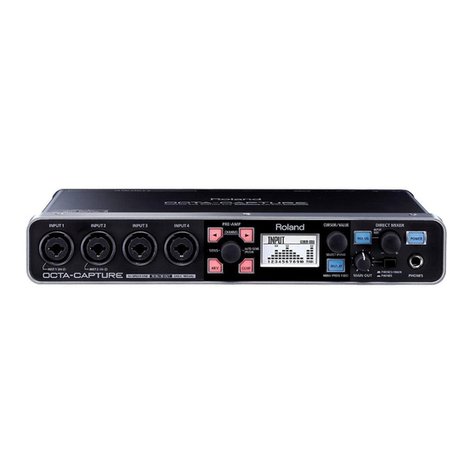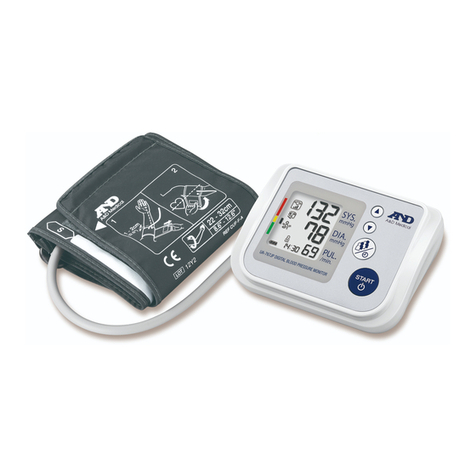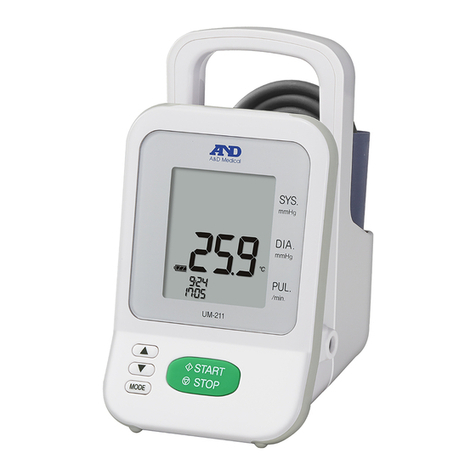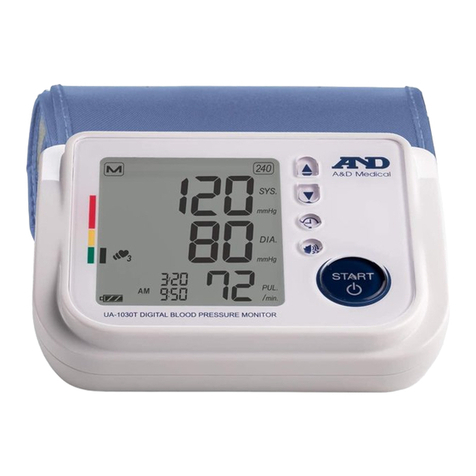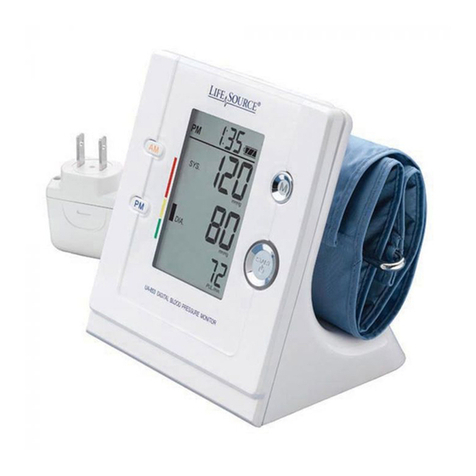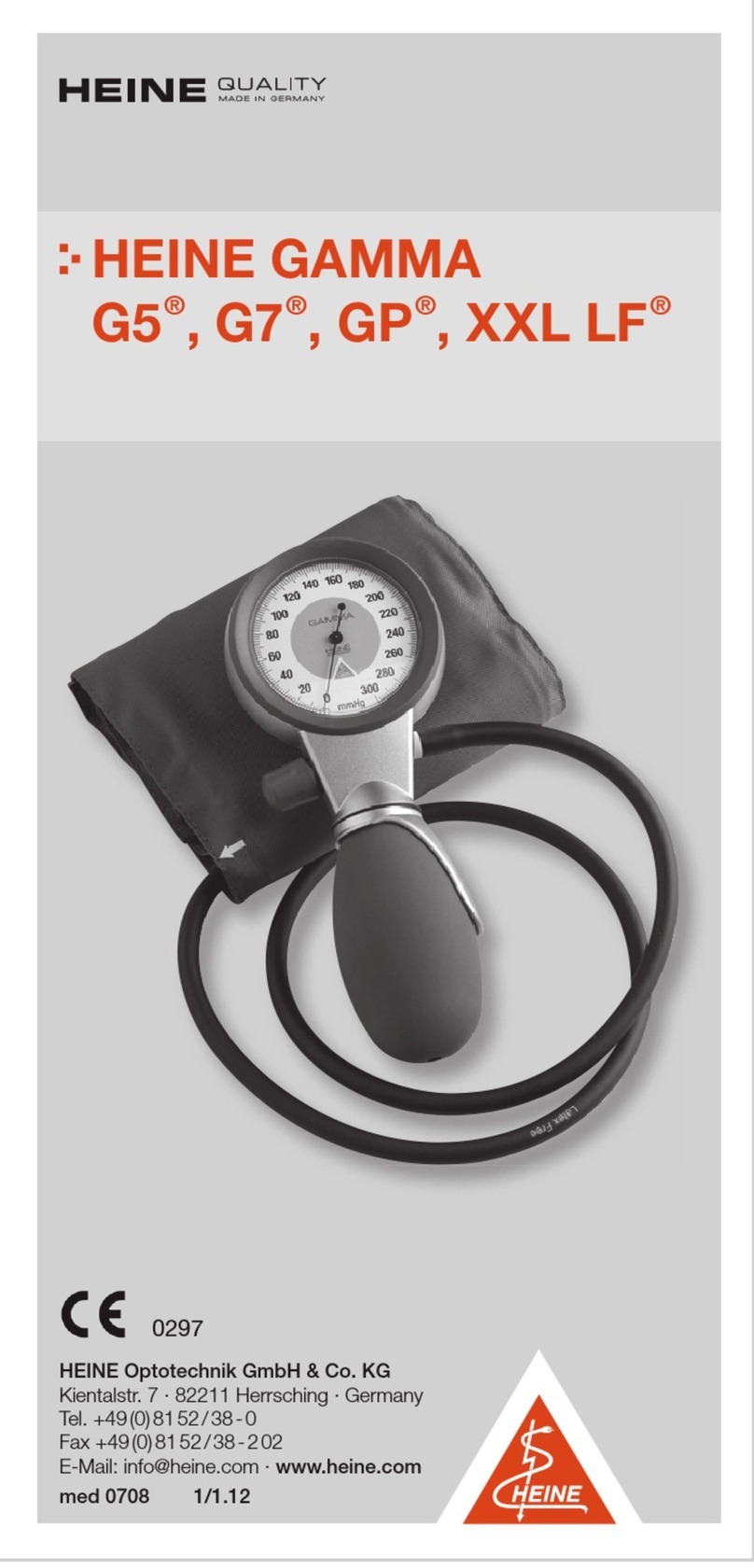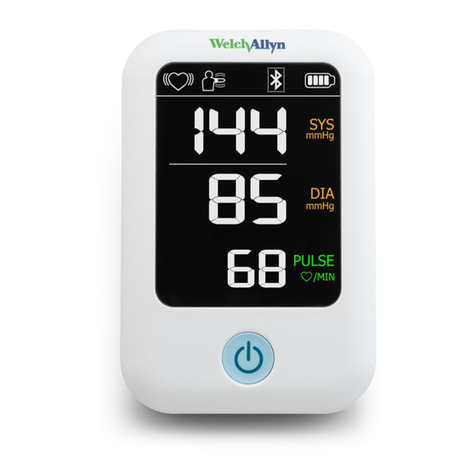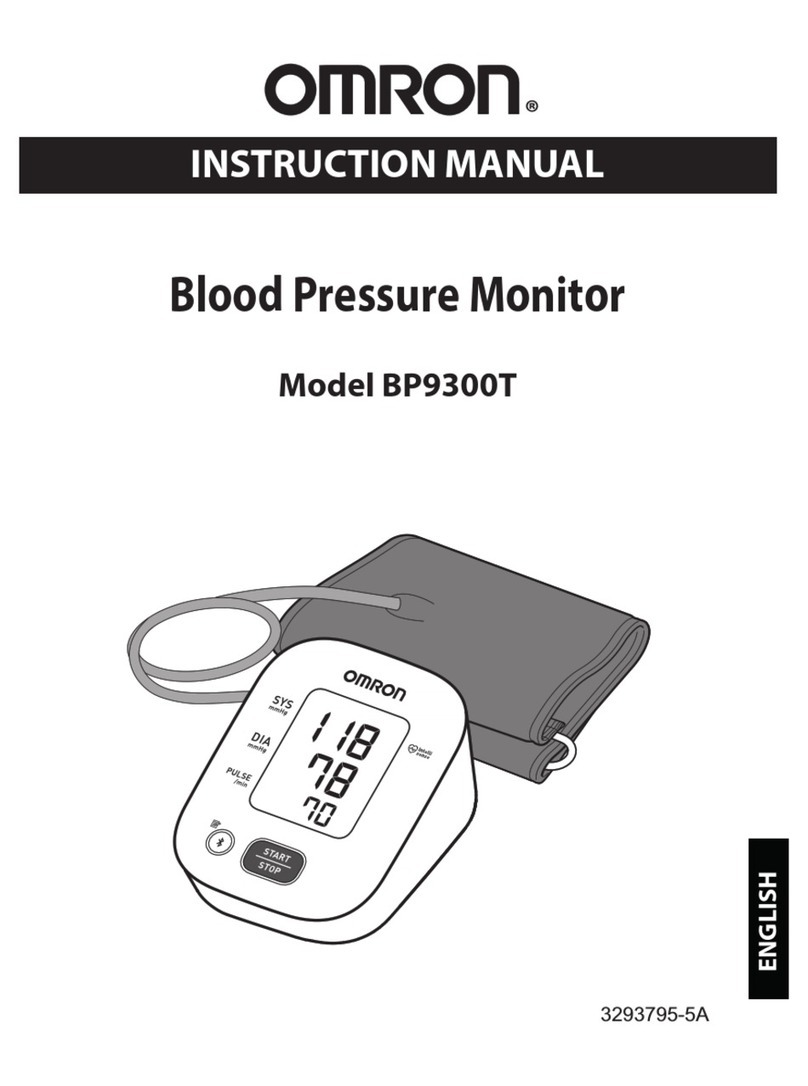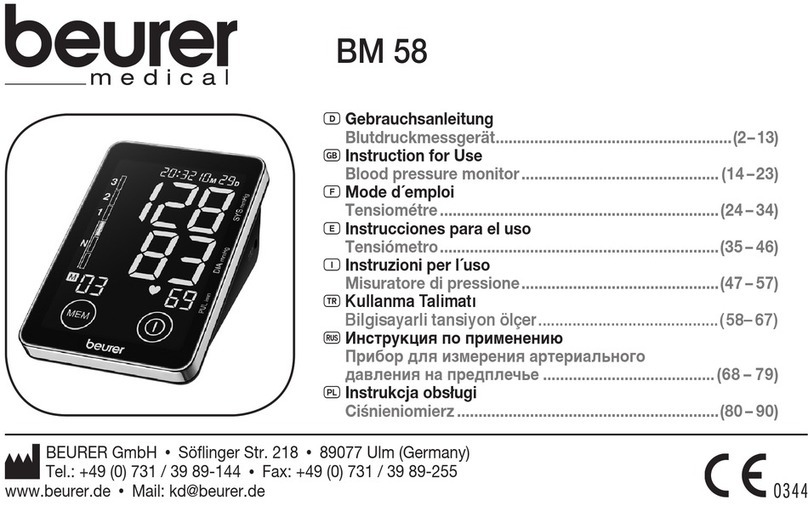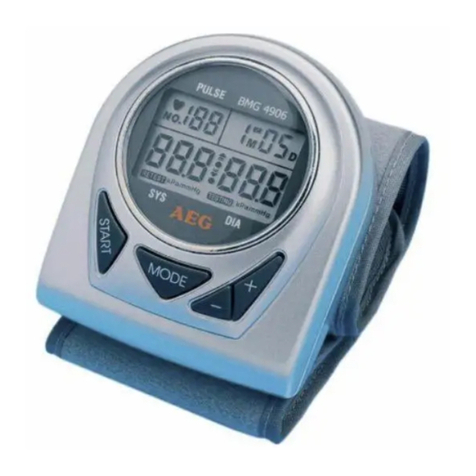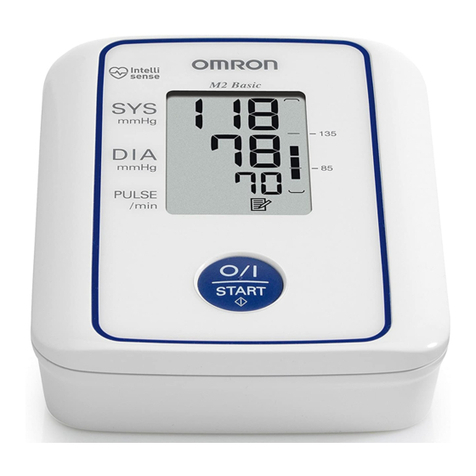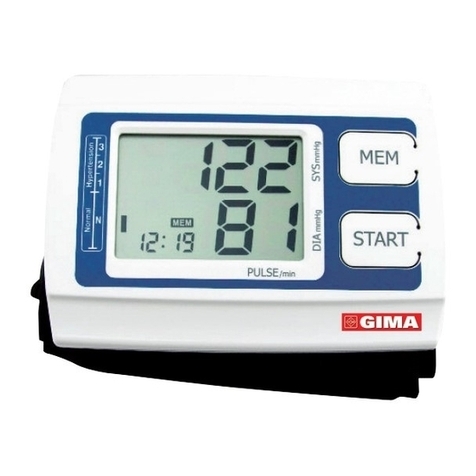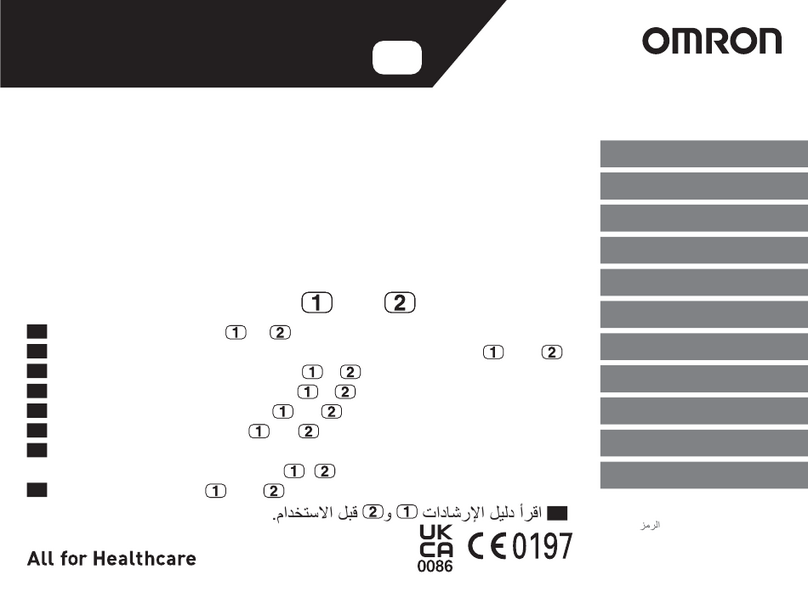AND UB-533 User manual

Wrist Digital Blood Pressure Monitor
Model UB-533
Instruction Manual
Original
Manuel d’instructions
Traduction
Manual de Instrucciones
Traducción
Manuale di Istruzioni
Traduzione
使用手冊
1WMPD4003121E
翻譯

English 1
Contents
Dear Customers ................................................................................................................................................... 2
Preliminary Remarks ........................................................................................................................................... 2
Precautions .......................................................................................................................................................... 2
Parts Identification ............................................................................................................................................... 4
Symbols ............................................................................................................................................................... 5
Using the Monitor ................................................................................................................................................. 8
1. Installing / Changing the Batteries .............................................................................................................. 8
2. Selecting a User ......................................................................................................................................... 9
3. Adjusting the Built-in Clock Before Use ...................................................................................................... 9
4. Applying the Cuff ...................................................................................................................................... 10
5. How to Take Accurate Measurements ..................................................................................................... 10
6. The C.P.G. Function Switch ...................................................................................................................... 11
7. Selecting the C.P.G. and my C.P.G. ........................................................................................................... 11
8. Measurement ........................................................................................................................................... 12
9. After Measurement ................................................................................................................................... 12
Measurements ................................................................................................................................................... 13
Recalling the Memory Data ............................................................................................................................... 14
Deleting Data Stored in Memory ........................................................................................................................ 15
What Is The IHB/AFib Indicator? ....................................................................................................................... 15
What Is The AFib? ............................................................................................................................................. 15
% IHB/AFib ........................................................................................................................................................ 16
Pressure Bar Indicator ....................................................................................................................................... 17
WHO Classification Indicator ............................................................................................................................. 17
The C.P.G. Indicator .......................................................................................................................................... 18
About Blood Pressure ........................................................................................................................................ 19
What is Blood Pressure? .............................................................................................................................. 19
What is Hypertension and How is it Controlled? .......................................................................................... 19
Why Measure Blood Pressure at Home? ..................................................................................................... 19
WHO Blood Pressure Classification ............................................................................................................. 20
Blood Pressure Variations ............................................................................................................................ 20
Troubleshooting ................................................................................................................................................. 21
Maintenance ...................................................................................................................................................... 22
Technical Data ................................................................................................................................................... 22

English 2
Dear Customers
Congratulations on purchasing a state-of-the-art A&D blood pressure monitor, one of the most advanced monitors
available today. Designed for ease of use and accuracy, this device will facilitate your daily blood pressure regimen.
We recommend that you read through this manual carefully before using the device for the first time.
Preliminary Remarks
This device conforms to the European Directive 93/42 EEC for Medical Products. This is made evident by the
mark of conformity. (0123: The reference number to the involved notified body)
The device is designed for use on adults, not newborns or infants.
Environment for use. The device is for use to operate by yourself in the home healthcare environment.
This device is designed to measure blood pressure and pulse rate of people for diagnosis.
Precautions
Precision components are used in the construction of this device. Extremes in temperature, humidity, direct
sunlight, shock or dust should be avoided.
Clean the device with a dry, soft cloth or a cloth dampened with water and a neutral detergent. Never use alcohol,
benzene, thinner or other harsh chemicals to clean the device.
Avoid tightly folding the cuff for long periods, as such treatment may shorten the life of the components.
The device is not water resistant. Prevent rain, sweat and water from soiling the device.
Measurements may be distorted if the device is used close to televisions, microwave ovens, cellular telephones,
X-ray or other devices with strong electrical fields.
Used equipment, parts and batteries are not treated as ordinary household waste, and must be disposed of
according to the applicable local regulations.
When reusing the device, confirm that the device is clean.
Do not modify the device. It may cause accidents or damage to the device.
To measure blood pressure, the wrist must be squeezed by the cuff hard enough to temporarily stop blood flow
through the artery. This may cause pain, numbness or a temporary red mark to the wrist. This condition will appear
especially when measurement is repeated successively. Any pain, numbness, or red marks will disappear with time.

English 3
Wireless communication device, such as home networking devices, mobile phones, cordless phones and their
base stations, walkie-talkies can affect this blood pressure monitor. Therefore, a minimum distance of 30 cm should
be kept from such devices.
Measuring blood pressure too frequently may cause harm due to blood flow interference. Check that the operation
of the device does not result in prolonged impairment of blood circulation, when using the device repeatedly.
Clinical testing has not been conducted on newborn infants and pregnant woman. Do not use on newborn infants
or pregnant woman.
If you have had a mastectomy, please consult a doctor before using the device.
Do not let children use the device by themselves and do not use the device in a place within the reach of infants. It
may cause accidents or damage.
There are small parts that may cause a choking hazard if swallowed by mistake by infants.
Do not touch the batteries and the patient at the same time. That may result in electrical shock.
In the case of single components failure enclosure of near cuff may become hot and potentially cause malfunction.
Use of accessories not detailed in this manual may compromise safety.
Should the battery short-circuit, it may become hot and potentially cause burns.
Allow the device to adapt to the surrounding environment before use (about one hour).
Do not inflate without wrapping the cuff around your wrist.
Contraindications
The following are precautions for proper use of the device.
Do not apply the device to a wrist with other medical electrical equipment attached. The equipment may not
function properly.
People who have a severe circulatory deficit in the arm must consult a doctor before using the device to avoid
medical problems.
Do not self-diagnose the measurement results and start treatment by yourself. Always consult your doctor for
evaluation of the results and treatment.
Do not apply the device on a wrist with an unhealed wound.
Do not apply the device on an arm receiving an intravenous drip or blood transfusion. It may cause injury or accidents.
Do not use the device where flammable gases such as anesthetic gases are present. It may cause an explosion.
Do not use the device in highly concentrated oxygen environments, such as a high-pressure oxygen chamber or an
oxygen tent. It may cause a fire or explosion.

English 4
Parts Identification
Display
Systolic pressure
Diastolic pressure
Correct Position Guidance (C.P.G.) indicator
IHB/AFib symbol
Pulse rate
Date & clock display
AM / PM mark
A
lkaline batteries (LR03 or AAA)
Battery cover
button ( average, memory and change of preset parameters)
SET button ( user and clock )
START button
Display
Heart mar
k
User and User
Battery indicator
MEMORY
Average
WHO classification indicator
and
Pressure bar indicator
Cuff
Cuff Fit Error S
y
mbol
Movement Error Symbol
%IHB/AFib

English 5
Symbols
Symbols that are printed on the device case
Symbols Function / Meaning
Standby and Turn the device on
Battery installation guide
Direct current
SN Serial number
Date of manufacture
Type BF: Device and cuff are designed to provide special protection against electrical shocks.
EC directive medical device label
IP International protection symbol
WEEE label
Manufacturer
EU-representative
Refer to instruction manual / booklet
Keep dry

English 6
Symbols that appear on the display
Symbols Function / Meaning / Recommended Action
Appears while measurement is in progress. It blinks when the pulse is detected.
Remain as still as possible.
IHB/AFib symbol appears when an irregular heartbeat is detected.
It may light when a very slight vibration like shivering or shaking is detected.
Appears when a body or arm movement is detected. The reading may yield an incorrect value. Take
another measurement. Remain still during measurement.
Appears during measurement when the cuff is attached loosely. The reading may yield an incorrect
value. Apply the cuff correctly, and take another measurement.
Deleted rate of IHB/AFib in memory
Number of detected
IHB/AFibs in memory
User 1 and user 2
%IHB
/
AFib
= x100 %
Total number

English 7
Symbols that appear on the display (continued)
Symbols Function / Meaning Recommended Action
Previous measurements stored in MEMORY
Average data
FULL BATTERY
The battery power indicator during measurement
LOW BATTERY
The battery is low when it blinks
Replace all batteries with new ones
when the indicator blinks.
or
Unstable blood pressure due to movement during measurement Take another measurement.
Remain still during measurement.
The systolic and diastolic values are within 10 mmHg of each other.
Apply the cuff correctly, and take
another measurement.
The pressure value did not increase during inflation.
The cuff is not applied correctly.
PUL. DISPLAY ERROR
The pulse is not detected correctly.
Blood pressure monitor internal error
Remove the batteries and press the
START button, and then install the
batteries again. If the error still
appears, contact the dealer.
SYS. Systolic blood pressure in mmHg
DIA. Diastolic blood pressure in mmHg
PUL Pulse per minute
AM Data taken between 4:00 and 9:59
PM Data taken between 18:00 and 1:59

English 8
Using the Monitor
1. Installing / Changing the Batteries
1. Remove the battery cover.
2. Remove the used batteries and insert new batteries into the
battery compartment as shown, taking care that the polarities
(+ and -) are correct. Use only LR03 or AAA batteries.
3. Attach the battery cover.
Insert the batteries as shown in the battery compartment.
If installed incorrectly, the device will not work.
When (LOW BATTERY mark) blinks on the display,
replace all batteries with new ones. Do not mix old and new
batteries. It may shorten the battery life, or cause the device
to malfunction.
(LOW BATTERY mark) does not appear when the
batteries are drained.
The battery life varies with the ambient temperature and may be shorter at low temperatures. Generally, two new
LR03/AAA batteries will last approximately for three months when used twice for measurement each day.
Use the specified batteries only. The batteries provided with the device are for testing monitor performance and
may have a limited life.
Remove the batteries if the device is not to be used for a long period of time. The batteries may leak and cause a
malfunction.
When removing the batteries, preset parameters (of clock, user and my C.P.G.) are reset.
Battery cover
Used batteries
New batteries

English 9
2. Selecting a User
1. Press the SET button when turning off the device. The indicator or is blinking.
2. Select a user from user and user using the SET button.
Press the START button to turn off the device.
After three minutes of non-operation, the device will turn off automatically.
3. Adjusting the Built-in Clock Before Use
1. Press and hold the SET button until the year starts blinking.
2. Select the year using the button.
Press the SET button to set the current year and move to month/day selection.
The date can be set anywhere between the years 2010 and 2059.
3. Select the month using the button.
Press the SET button to set the current month and move to day selection.
4. Select the day using the button.
Press the SET button to set the current day and move to hour/minute selection.
5. Select the hour using the button.
Press the SET button to set the current hour and move to minute selection.
6. Select the minute using the button.
Press the SET button to proceed to "6.The C.P.G.Function Switch".
Holding down the button will change the value continuously.
Pressing the START button will turn the device off anytime.
Notes: After three minutes of non-operation, the device will turn off automatically. When the clock has not been set,
is indicated for the clock display. When removing the batteries, preset parameters (of clock, user and my C.P.G.) are
reset.
User or User
START button
SET button
Turn off
button
SET button
SET button
button
SET button
SET button
button
Press and hold SET button
button
button
Year
Month
Day
Hour
Minute
SET button
The operation proceeds to
"6. The C.P.G. Function Switch".

English 10
4. Applying the Cuff
1. Wrap the cuff around your wrist about 1 cm above your hand as shown in the figure
at the right.
2. Apply the cuff tightly using the Velcro strip.
Note: For accurate measurements, apply the cuff tightly and measure on a bare wrist.
5. How to Take Accurate Measurements
For the most accurate blood pressure measurement:
Remain still and keep quiet during measurement.
Sit down in a comfortable position. Place your elbow on a table with your palm facing upward and the cuff is at the
same level as your heart.
Relax for about five to ten minutes before measurement. If you are excited or depressed by emotional stress, the
measurement will reflect this stress as a higher (or lower) than normal blood pressure reading and the pulse
reading will usually be faster than normal.
Try to measure your blood pressure at about the same time every day.
An individual's blood pressure varies constantly, depending on what they are doing, what they have eaten and what
they drink can have a very strong and rapid effect on your blood pressure.
Do not measure immediately after physical exercise or a bath. Rest for twenty or thirty minutes before taking the
measurement.
Do not cross your legs. Keep your feet flat on the floor and straighten your back.
This device bases its measurements on the heartbeat. If you have a very weak or irregular heartbeat, the device
may have difficulty determining your blood pressure.
Should the device detect a condition that is abnormal, it will stop the measurement and display an error symbol.
See page 7 for the description of symbols.
This blood pressure monitor is intended for use by adults. Consult with your physician before using this device on a
child. A child should not use this device unattended.
The automatic blood pressure monitor's performance may be affected by excessive temperature or humidity, or altitude.
About 1 cm

English 11
6. The C.P.G. Function Switch
Refer to page 18 for the C.P.G. function that will indicate the proper
angle so that the height of the cuff is the same level as your heart.
1. After step 6 in page 9, press the button to select either " " or
"" concerning the C.P.G. function.
2. Press the SET button to store the selection.
3. If you do not use my C.P.G. function, press START button
to turn off. Proceed to "8. Measurement".
If you use my C.P.G. function, proceed to "7. Selecting the
C.P.G. and my C.P.G.".
7. Selecting the C.P.G. and my C.P.G.
You can select an indicator either the C.P.G. function or my C.P.G. .
Preset a proper posture (wrist angle) in memory if you use the my C.P.G. .
1. Adjust and keep the height of the blood pressure monitor to
the same level as your heart using your wrist angle.
2. Select an indicator using the button.
Indicator ....... The C.P.G. function is used. (my C.P.G. function : OFF )
Data of my C.P.G. is deleted. Proceed to step 3.
Indicator ..... my C.P.G. function is ON and the current angle is stored
when switched to the indicator . Proceed to step 3.
3. Press the START button to turn off the device.
Note: When removing the batteries, preset parameters (of clock,
user and my C.P.G.) are reset.
Select a user from user and user using the SET
button.
From step 6 of page 9
The C.P.G. function
button
Press the SET button
To "7. Selecting the C.P.G. and my C.P.G." or
START button and to "8. Measurement"
Step 1 [Adjust and keep the height
of the device (wrist angle) ]
HIGH
(Orange light)
Correct Height
(Blue light)
LOW
(Orange light)
Step 2
[
Select The C.P.G. or my C.P.G.]
The C.P.G. function My C.P.G.
button
Ex.: user 1
START button and to "8. Measurement"
The C.P.G. indicator

English 12
8. Measurement
During measurement, it is normal for the cuff to feel very tight.
9. After Measurement
While readings are displayed, if you press the START button to turn the device off, new readings are stored in
memory.
While readings are displayed, if you press the button to turn the device off, new readings are not stored.
Remove the cuff and record your data.
Notes: The device is provided with an automatic power shut-off function which stores the current data in the
memory and turns the device off automatically one minute after measurement. Allow at least three minutes
between measurements on the same person.

English 13
Measurements
Note: The UB-533, once used, will provide an inflation appropriate to the user.
1. Wrap the cuff around your wrist. Sit comfortably with the cuff at the same level
as your heart and relax.
2. Press the START button. All of the display segments are displayed.
3. Select a user from user and user using the SET button immediately.
Adjust and keep the height of the cuff (with blue light) to the same level as your
heart using the C.P.G. indicator.
Note
s: If you do not use user selection, wait for the inflation for several seconds.
If you do not use the C.P.G. function, the C.P.G. indicator is not displayed.
4. Zero (0) is displayed blinking briefly. Then the display changes, as
measurement begins. The cuff starts to inflate. It is normal for the cuff
to feel very tight. The measurement starts automatically when
inflation starts, and the (heart mark) blinks.
Note: If you wish to stop inflation at any time, press the START button again.
5. When the measurement is complete, the device displays readings
( of the systolic and diastolic pressure readings, pulse rate, WHO
classification, I.H.B. symbol and C.P.G. indicator). While readings are
displayed, the date and time are displayed alternately. The cuff
exhausts the remaining air and completely deflates automatically.
Note: If you do not want to store new readings in memory, press the
button while readings are displayed.
6. Press the START button again to turn the device off. Remove the cuff.
Notes
: The device is provided with an automatic power shut-off function.
Allow at least three minute between measurements on the same person.
A
t heart level
PUL.
AM
PUL.
AM
PM
User or User : SET button
The C.P.G. indicator:
Orange Blue Orange
LOW LEVEL HIGH
Zero displa
y
Inflation is started
Inflating and
Measurement in progress
Systolic pressure
Diastolic pressure
WHO classification
I.H.B. symbol
Pulse rate
The C.P.G. indicator
All segments

English 14
Recalling the Memory Data
Note: This device stores the last 60 measurements in memory.
1. Press the button when turning the device off.
The average of all measurements and the number of data are displayed.
If no data, “0” is displayed. Press the or START button to turn the
device off.
2. Use the following buttons to display data (of number and measurement data).
Select a user from user and user using the SET button.
The device displays the average of all measurements and the
number of data are displayed.
Pressing the button each time , the device displays as follows:
Average data of all AM (morning) measurements taken between
4:00 and 9:59. In the example, If no data, is displayed.
Average data of all PM (evening) measurements taken between
18:00 and 1:59.
Data (of number and measurement data).
The device displays in order from most recent data. The date
and time are displayed alternately while displaying the
measurement data.
In the example: No.30 & data No.29 & data No.01 & data.
3. If you press the button after oldest data is displayed, the device
proceeds to step 1, the average of all measurements and the number of
data are displayed.
4. Press the START button to turn the device off.
After one minute of non-operation, the device will turn off automatically.
Memory mode
User selection
Example: user
A
verage of all the
data
Number of all data
Average for AM data
AM indicator
Number of AM data
Average for PM data
PM indicator
Number of PM data
Ex.: No.30
Most recent data
Date
Time
3 seconds
Last data (Oldest)
Date
Time
3 seconds
Turn of
f
button
button
button
button
button
button
button
button
Turn of
f

English 15
Deleting Data Stored in Memory
1. Select a user from user and user using the SET button. Turn off the
device using the START button.
2. Press and hold the button until turning off the device automatically.
The device displays a user icon and the mark, deletes data stored in
memory while blinking the mark and turns off automatically.
Note: This operation will delete specified user data stored in memory.
You cannot select which data to delete.
What Is The IHB/AFib Indicator?
When the monitor detects an irregular rhythm during the measurements, the IHB/AFib indicator will appear on the
display with the measurement values.
Note: We recommend contacting your physician if you see this IHB/AFib indicator frequently.
What Is The AFib?
The heart contracts due to electrical signals occurring in heart and sends blood through the body. Atrial fibrillation (AFib)
occurs when the electrical signal in the atrium becomes confused and leads to disturbances in the pulse interval. AFib
can cause blood to stagnate in the heart, which can easily create clots of blood, a cause of stroke and heart attack.
Turn off
SET button
User or User
Display is turned off
Press and hold button
Ex.: User
Deleting data
Display is turned off
Release button

English 16
% IHB/AFib
%IHB/AFib is displayed as frequency of IHB detected.
IHB/AFib can detect not only noises such as physical movement but also an irregular heartbeat.Therefore,we
recommend contacting your physician if %IHB/AFib level is high.
Display of %IHB/AFib: %IHB/AFib is displayed when displaying average values.
%IHB/AFib is not displayed when the memory number is six or less.
Level 0
%IHB/AFib=0
Level 1
%IHB/AFib=1 - 9
Level 2
%IHB/AFib=10 - 24
Level 3
%IHB/AFib=25 - 100
Not displayed
%IHB
/
AFib =
A
verage value displa
y
Number of detected
IHB/AFib s in memory
x100 %
Total number

English 17
Pressure Bar Indicator
The indicator monitors the progress of pressure during measurement.
WHO Classification Indicator
Each six segments of the bar indicator correspond to the
WHO blood pressure classification is described on 20 page.
Example
Moderate
hypertension Mild hypertension High normal
: The indicator displays a segment, based on the
current data, corresponding to the WHO
classification.
WHO Classification Indicator
Severe hypertension
Moderate hypertension
Mild hypertension
High normal
Normal
Optimal
Pressurizing
Inflation in progress
Measurement in progress
Inflation complete

English 18
The C.P.G. Indicator
The C.P.G. Indicator
The C.P.G. (Correct Position Guidance) indicator is the function to inform a
difference between the height (wrist angle) of the blood pressure monitor and
your cardiac height in the correct posture (Example: sitting posture, height of
table and chair, etc.) during the measurement. The indicator can be used to
get more stable measurement condition.
The C.P.G. Indicator
The height of the blood pressure
monitor is lower than your heart.
Low angle
Incorrect Height
The height of the blood pressure
monitor is the same level as your
heart.
Proper angle
Correct Height
The height of the blood pressure
monitor is higher than your heart.
High angle
Incorrect Height
The position of the device is checked both before and after measurement If both
checks show a correct measurement position the LEVEL indicator is lit(blue).
For all other measurements an indicator for LOW or HIGH measurement
position will be lit (orange).
How To Use My C.P.G.
The C.P.G. function can be used with proper posture (wrist angle) in the majority
of measurements. If you need to change the posture to adjust the height so that
the height of the blood pressure monitor is the same level as your cardiac
height, you can use my C.P.G. function to store a personal posture. Preset your
angle to my C.P.G. function before measurement.
Proper Posture
Sit straight back on a
chair and put your
elbow on a table.
Table Chair
The C.P.G. indicator
The C.P.G. indicator : LOW The C.P.G. indicator : LEVEL The C.P.G. indicator : HIGH

English 19
The Indicator During Measurement And Recalling Memory
The C.P.G. indicator can be displayed at the beginning of measurement and is included in data stored in the memory.
Adjust and keep the angle during measurement.
About Blood Pressure
What is Blood Pressure?
Blood pressure is the force exerted by blood against the walls of the arteries. Systolic pressure occurs when the
heart contracts. Diastolic pressure occurs when the heart expands. Blood pressure is measured in millimeters of
mercury (mmHg). One's natural blood pressure is represented by the fundamental pressure, which is measured
first thing in the morning while one is still at rest and before eating.
What is Hypertension and How is it Controlled?
Hypertension, an abnormally high arterial blood pressure, if left unattended can cause many health problems
including stroke and heart attack. Hypertension can be controlled by altering lifestyle, avoiding stress, and with
medication under a doctor’s supervision.
To prevent hypertension or keep it under control:
Do not smoke Exercise regularly
Reduce salt and fat intake Have regular physical checkups
Maintain proper weight
Why Measure Blood Pressure at Home?
Blood pressure measured at a clinic or doctor's office may cause apprehension and can produce an elevated
reading, 25 to 30 mmHg higher than that measured at home. Home measurement reduces the effects of outside
influences on blood pressure readings, supplements the doctor's readings and provides a more accurate, complete
blood pressure history.
Table of contents
Other AND Blood Pressure Monitor manuals


